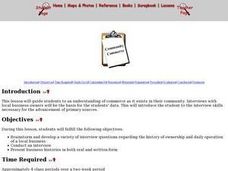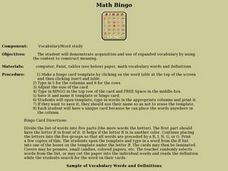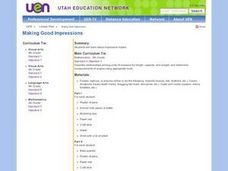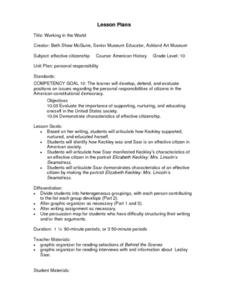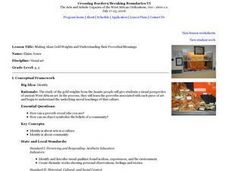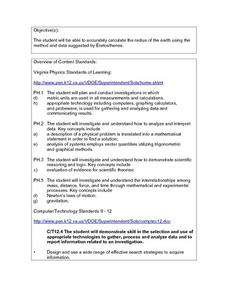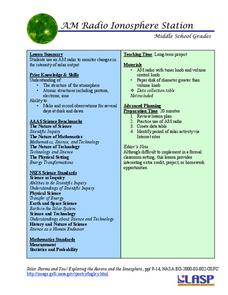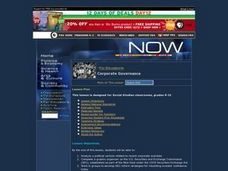Curated OER
Farming in a Fishbowl: How Ethnic Groups in
Seventh graders research Chinese agricultural needs and practices. They conduct an experiment with aquaculture and germinated rice as they take measurements and apply the scientific method.
Curated OER
GET THE POINT!
The student will measure the width of the horns on drawings of longhorn cattle and then convert the measurements from inches to centimeters and from inches to feet.1. Review with students the steps required to measure an item and to...
Curated OER
Geometry: Classifying Angles
Learners measure, construct, and classify angles as acute, right, straight, and obtuse. Once they have completed an angle worksheet, students use a map of South Carolina to locate cities by constructing the aforementioned angles.
Curated OER
Location of Cities 201
Students work in pairs to locate the ancient cities on a world atlas using the longitude and latitude measurements. They examine the physical and human futures that explain their locations.
Curated OER
Community Commerce
Sixth graders explore commerce in their own community. They interview local business owners and collect data about their town. Students research the history of a local business and its daily operation. They prepare a presentation to...
Curated OER
Math Bingo!
Students discover how to change units of measurement by multiplication and division applications. They play math bingo solving multiplication and division problems. Students review their anwers by checking them in class.
Curated OER
Mapping It Out - Great Lessons For Geography
Through geography lesson plans students can learn about history, science, and a variety of other subjects.
Curated OER
Making Good Impressions
Fourth graders participate in an experiment where they experiment with impression fossils. They identify and describe the measurable attributes of the impression fossils. There are many parts and materials for this experiment.
Curated OER
Groundhog Day
Pupils access a variety of Groundhog Day themed websites. They locate information about the history of Groundhog Day and why we celebrate it. They read about Punxsutawney Phil and groundhogs and play interactive games.
Curated OER
Beat the Greeks
Students conduct research of the history of atomic theory. Information is presented from Democritus and Aristotle to the early Renaissance using the Internet and video.The integration of technology allows for a vast amount of research...
Curated OER
Creating Family Memories While Making Bread
Young scholars work together to make fry bread. They measure out the correct amounts of each ingredient and reflect how it is part of their culture. Using the internet, they research recipes from different cultures and write about their...
Curated OER
Working In The World
Tenth graders engage in research about the life of Keckley. They examine specific events that display the characteristics of good citizenship. The effectiveness of using different tactics by Keckley is discussed in small group to measure...
Curated OER
Zhou Dynasty
Students research the contributions of the Zho Dynasty. They identify the Mandate of Heaven, and the growth of the economy under the Zhou. They research the history of the discovery of silk and its role as an export. Finally, they...
Curated OER
Using Solar Energy
Students experiment to determine the effect of solar energy on the temperature of water. For this renewable resources lesson, students measure the temperature of water in a flask that is exposed to sunlight. They relate their results to...
Curated OER
The Big O
Students investigate the characteristics of a community. They investigate the characteristics of the Omaha community through internet research and discussion. Students create books about their community.
Curated OER
Making Akan Gold Weights and Understanding their Proverbial Meanings
Students examine a variety of gold weights used by the Asante in West Africa. In groups, they discuss the purpose of the gold weights and practice saying proverbs associated with different pieces of art. To end the lesson, they...
Curated OER
Looking into Eratosthenes' Radius of the Earth
Students, in small groups, research Eratosthenes and his calculations of the Earth's radius. They write a summary of the person, the experiments and his calculations to determine how accurate Eratosthenes was in his estimations of the...
Polar Trec
Animal Monitoring Introduction
Not only do mealworms taste great, they are also great for classroom science lessons. In pairs, young scientists observe and record what they see as they check out what their mealworms are doing from minute to minute. Each minute...
PHET
AM Radio Ionosphere Station
Tune in! Young scientists use an AM radio at home to monitor solar output. The long-term project would be ideal in a flipped classroom or as an out-of-class project.
Foreign Policy Research Institute
Understanding China: The Prospects for Democracy in China
This document provides useful information for a unit on democracy in China. While it does not include detailed activities, it does have a list of democratic principles, and important facts about China that facilitate understanding of its...
Curated OER
Innovations In Adult Care
Students study scientists and the important Nobel Prize dates. In this investigative lesson students divide into groups and watch a program then complete a project.
Curated OER
Introduction to Hours & Minutes
First graders identify, interpret, and gain proficiency in using a clock to tell time to the hour and determine how many minutes are in an hour. They identify and list what they do as they travel through their dayand how much time you...
Curated OER
Corporate Governance
Examine the role of the Securities Exchange Commission. Upper graders watch a short Bill Moyers video, analyze a political cartoon, complete a graphic organizer on the SEC, and develop SEC reform strategies to rebuild investor confidence.
Chicago Botanic Garden
Historical Climate Cycles
What better way to make predictions about future weather and climate patterns than with actual climate data from the past? Young climatologists analyze data from 400,000 to 10,000 years ago to determine if climate has changed over time....






